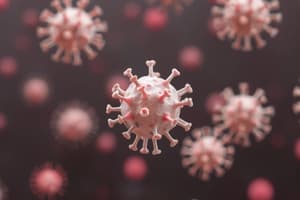Podcast
Questions and Answers
Why is Plasmodium falciparum considered the most dangerous malaria species?
Why is Plasmodium falciparum considered the most dangerous malaria species?
- It is more easily transmitted by mosquitoes than other species.
- It is responsible for the majority of malaria-related deaths globally due to its virulence. (correct)
- It is the only species that can cause malaria in pregnant women.
- It is resistant to ACTs.
What is the primary reason that malaria vaccine development is difficult?
What is the primary reason that malaria vaccine development is difficult?
- The _Plasmodium_ parasite has a complex life cycle and exhibits antigenic variation. (correct)
- There is little funding available for malaria vaccine research.
- The disease is only present in remote locations.
- Mosquitoes develop resistance to the vaccine.
How do artemisinin-based combination therapies (ACTs) combat malaria?
How do artemisinin-based combination therapies (ACTs) combat malaria?
- By preventing mosquitoes from biting infected individuals.
- By targeting the parasite during its erythrocytic stage in humans. (correct)
- By boosting the immune system.
- By eliminating the parasite from the mosquito vector.
If a patient is suspected of having malaria, but lives in an area with limited resources, what is the most likely diagnostic method used?
If a patient is suspected of having malaria, but lives in an area with limited resources, what is the most likely diagnostic method used?
What is the role of the Anopheles mosquito in malaria transmission?
What is the role of the Anopheles mosquito in malaria transmission?
Which of the following is NOT a public health strategy for malaria control?
Which of the following is NOT a public health strategy for malaria control?
During which stage of the Plasmodium life cycle do malaria's clinical symptoms manifest in humans?
During which stage of the Plasmodium life cycle do malaria's clinical symptoms manifest in humans?
What is the primary way that insecticide-treated bed nets (ITNs) reduce malaria transmission?
What is the primary way that insecticide-treated bed nets (ITNs) reduce malaria transmission?
Aside from drugs, what is the best approach to controlling Malaria?
Aside from drugs, what is the best approach to controlling Malaria?
Which of the following is a major challenge to global malaria control efforts?
Which of the following is a major challenge to global malaria control efforts?
Which of the following is the correct pairing of malaria species and relative danger?
Which of the following is the correct pairing of malaria species and relative danger?
While awaiting diagnostic confirmation in a resource-limited setting, a patient presents with a fever, chills, and headache. They live in an area known for high malaria prevalence. What immediate step is most appropriate?
While awaiting diagnostic confirmation in a resource-limited setting, a patient presents with a fever, chills, and headache. They live in an area known for high malaria prevalence. What immediate step is most appropriate?
Which intervention would be MOST effective in preventing malaria transmission in a rural sub-Saharan African community with high mosquito density and limited access to healthcare?
Which intervention would be MOST effective in preventing malaria transmission in a rural sub-Saharan African community with high mosquito density and limited access to healthcare?
In an area with widespread chloroquine-resistant Plasmodium falciparum, which of the following antimalarial drugs would be the MOST appropriate alternative for treating uncomplicated malaria?
In an area with widespread chloroquine-resistant Plasmodium falciparum, which of the following antimalarial drugs would be the MOST appropriate alternative for treating uncomplicated malaria?
A pregnant woman in her first trimester is diagnosed with Plasmodium vivax malaria. Which of the following antimalarial medications is generally considered SAFE to use during this stage of pregnancy?
A pregnant woman in her first trimester is diagnosed with Plasmodium vivax malaria. Which of the following antimalarial medications is generally considered SAFE to use during this stage of pregnancy?
A traveler is planning a trip to a malaria-endemic region. What is the MOST effective personal protective measure they can take to prevent malaria infection?
A traveler is planning a trip to a malaria-endemic region. What is the MOST effective personal protective measure they can take to prevent malaria infection?
Which of the following best describes the action of the RTS,S/AS01 (Mosquirix) malaria vaccine?
Which of the following best describes the action of the RTS,S/AS01 (Mosquirix) malaria vaccine?
What is the MOST accurate description of Integrated Vector Management (IVM) in malaria control?
What is the MOST accurate description of Integrated Vector Management (IVM) in malaria control?
Which of the following is a potential consequence of climate change on malaria transmission?
Which of the following is a potential consequence of climate change on malaria transmission?
Following successful treatment for P. vivax malaria, a patient is prescribed primaquine. What is the PRIMARY reason for this medication?
Following successful treatment for P. vivax malaria, a patient is prescribed primaquine. What is the PRIMARY reason for this medication?
Flashcards
Malaria
Malaria
A life-threatening disease caused by parasites of the genus Plasmodium.
Malaria Transmission
Malaria Transmission
Transmitted through the bite of infected female Anopheles mosquitoes.
Plasmodium species causing malaria
Plasmodium species causing malaria
P. falciparum, P. vivax, P. ovale, P. malariae, and P. knowlesi.
Plasmodium falciparum
Plasmodium falciparum
Signup and view all the flashcards
Malaria prevalence
Malaria prevalence
Signup and view all the flashcards
Plasmodium life cycle in humans
Plasmodium life cycle in humans
Signup and view all the flashcards
Symptoms of malaria
Symptoms of malaria
Signup and view all the flashcards
Severe malaria complications
Severe malaria complications
Signup and view all the flashcards
Diagnosing malaria
Diagnosing malaria
Signup and view all the flashcards
Rapid Diagnostic Tests (RDTs)
Rapid Diagnostic Tests (RDTs)
Signup and view all the flashcards
Treatment of uncomplicated malaria
Treatment of uncomplicated malaria
Signup and view all the flashcards
Malaria vector control measures
Malaria vector control measures
Signup and view all the flashcards
Personal protection against malaria
Personal protection against malaria
Signup and view all the flashcards
Prophylactic antimalarial drugs
Prophylactic antimalarial drugs
Signup and view all the flashcards
RTS,S/AS01 (Mosquirix)
RTS,S/AS01 (Mosquirix)
Signup and view all the flashcards
Challenges to malaria control
Challenges to malaria control
Signup and view all the flashcards
WHO malaria targets
WHO malaria targets
Signup and view all the flashcards
Integrated malaria control
Integrated malaria control
Signup and view all the flashcards
Public health education
Public health education
Signup and view all the flashcards
Study Notes
- Microbiology is the study of microorganisms, including bacteria, archaea, fungi, protists, and viruses.
- Microbiology encompasses various sub-disciplines like bacteriology, virology, mycology, and parasitology.
- Microorganisms are ubiquitous and play crucial roles in nutrient cycling, biodegradation, and human health.
- They can be both beneficial (e.g., gut flora, bioremediation) and harmful (e.g., pathogens causing infectious diseases).
- Advancements in microbiology have led to the development of antibiotics, vaccines, and diagnostic tools.
- Culture-dependent and culture-independent methods are used to study microorganisms.
- Culture-dependent methods involve growing microorganisms in the lab, while culture-independent methods analyze genetic material directly from the environment.
- Molecular techniques like PCR and sequencing have revolutionized microbial identification and classification.
- Microscopy is a fundamental tool in microbiology, allowing visualization of microorganisms and their structures.
- Gram staining is a differential staining technique that distinguishes bacteria based on their cell wall structure.
- Understanding microbial genetics is crucial for studying antibiotic resistance, virulence factors, and metabolic pathways.
- Microorganisms evolve rapidly, leading to the emergence of antibiotic-resistant strains and novel pathogens.
- Biofilms are complex communities of microorganisms attached to surfaces, often exhibiting increased resistance to antibiotics and disinfectants.
- Public health microbiology focuses on the detection, prevention, and control of infectious diseases.
- Food microbiology examines the role of microorganisms in food spoilage, fermentation, and foodborne illnesses.
- Environmental microbiology studies the interactions of microorganisms with their environment, including soil, water, and air.
- Industrial microbiology utilizes microorganisms for the production of various products, such as enzymes, antibiotics, and biofuels.
- The human microbiome refers to the collection of microorganisms living in and on the human body, playing a vital role in health and disease.
Malaria
- Malaria is a life-threatening disease caused by parasites of the genus Plasmodium.
- It is transmitted to humans through the bite of infected female Anopheles mosquitoes.
- There are five Plasmodium species that cause malaria in humans: P. falciparum, P. vivax, P. ovale, P. malariae, and P. knowlesi.
- P. falciparum is the most virulent species, responsible for the majority of malaria-related deaths globally.
- Malaria is prevalent in tropical and subtropical regions, particularly in sub-Saharan Africa, Asia, and Latin America.
- The life cycle of Plasmodium involves both the mosquito and human hosts.
- In the human host, the parasite undergoes asexual reproduction in the liver (exoerythrocytic stage) and red blood cells (erythrocytic stage).
- The erythrocytic stage is responsible for the clinical symptoms of malaria, including fever, chills, sweating, and headache.
- Severe malaria can lead to complications such as cerebral malaria, severe anemia, acute respiratory distress syndrome (ARDS), and kidney failure.
- Diagnosis of malaria typically involves microscopic examination of blood smears to identify parasites.
- Rapid diagnostic tests (RDTs) based on the detection of parasite antigens are also widely used, particularly in resource-limited settings.
- Treatment of malaria depends on the Plasmodium species, the severity of the infection, and the patient's age and pregnancy status.
- Artemisinin-based combination therapies (ACTs) are the first-line treatment for uncomplicated P. falciparum malaria.
- Other antimalarial drugs include chloroquine, quinine, mefloquine, and atovaquone-proguanil.
- Prevention of malaria involves vector control measures, such as insecticide-treated bed nets (ITNs) and indoor residual spraying (IRS).
- Personal protective measures include using insect repellent, wearing long-sleeved clothing, and avoiding outdoor activities during peak mosquito biting times.
- Prophylactic antimalarial drugs can be taken by travelers to malaria-endemic areas to prevent infection.
- Vaccine development for malaria has been challenging due to the complex life cycle of the parasite and antigenic variation.
- RTS,S/AS01 (Mosquirix) is the first malaria vaccine to be licensed for use in children, providing partial protection against P. falciparum malaria.
- Research efforts are ongoing to develop more effective malaria vaccines and drugs.
- The World Health Organization (WHO) has set ambitious targets for malaria control and elimination, including reducing malaria incidence and mortality by 90% by 2030.
- Climate change, drug resistance, and insecticide resistance pose significant challenges to malaria control efforts.
- Integrated approaches that combine vector control, drug treatment, and surveillance are essential for achieving malaria elimination.
- Public health education and community engagement play a crucial role in preventing and controlling malaria.
Studying That Suits You
Use AI to generate personalized quizzes and flashcards to suit your learning preferences.




